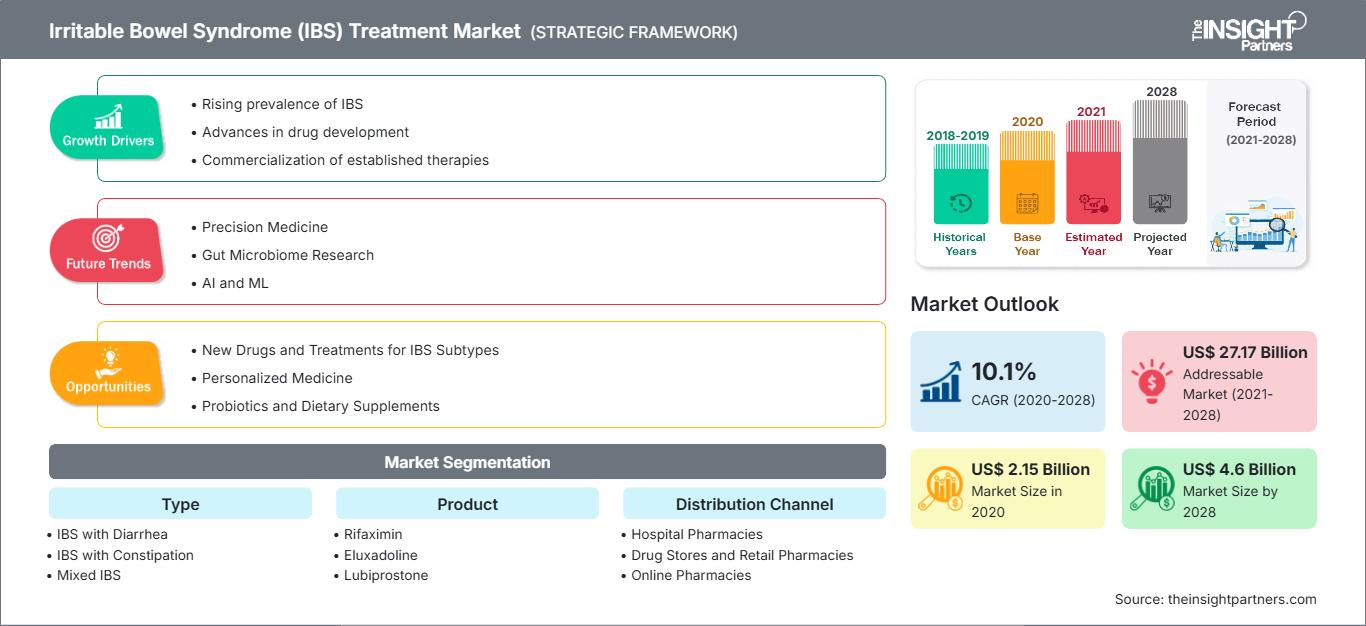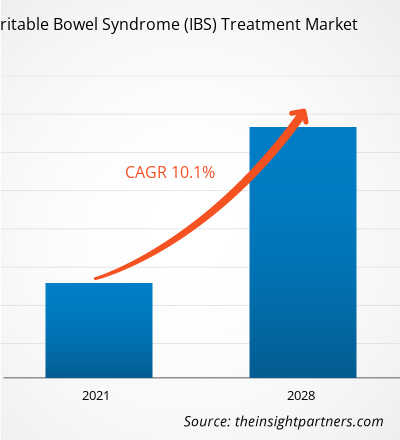El mercado de tratamiento del síndrome del intestino irritable (SII) se valoró en US$ 2.153,89 millones en 2020 y se proyecta que alcance los US$ 4.600,30 millones en 2028; se espera que crezca a una CAGR del 10,1% entre 2021 y 2028.
Factores clave como la creciente prevalencia del síndrome del intestino irritable y el aumento de las actividades de investigación y desarrollo impulsan el crecimiento del mercado. Sin embargo, la disponibilidad limitada de productos y la ineficacia de los tratamientos limitan dicho crecimiento. El SII es una enfermedad crónica común que afecta el intestino grueso. También se conoce como colon espástico, colitis mucosa, colon irritable y colitis espástica. Esta enfermedad es muy diferente de la enfermedad inflamatoria intestinal. Presenta síntomas como calambres, dolor abdominal, distensión abdominal, gases y diarrea o estreñimiento, o ambos a la vez. Si los síntomas son leves, se pueden controlar modificando el estrés, el estilo de vida y la dieta. Por otro lado, los síntomas graves se tratan con medicación y terapia.
En la región APAC, se han implementado numerosas medidas para contener la propagación del nuevo coronavirus, causante de la COVID-19. Estas medidas han interrumpido las operaciones de muchas empresas de diversos sectores, incluido el de la salud. La cuarentena del personal, las fallas en la cadena de suministro y la reducción de la demanda han generado graves complicaciones para las empresas. Además, se ha producido una disminución significativa de la atención hospitalaria y ambulatoria en las cadenas hospitalarias privadas. Para aliviar la carga de trabajo de los sistemas de salud, muchas clínicas están posponiendo citas no esenciales. Esta situación está obstaculizando el crecimiento del tratamiento del síndrome del intestino irritable (SII).
Obtendrá personalización en cualquier informe, sin cargo, incluidas partes de este informe o análisis a nivel de país, paquete de datos de Excel, así como también grandes ofertas y descuentos para empresas emergentes y universidades.
Mercado de tratamiento del síndrome del intestino irritable (SII): Perspectivas estratégicas

-
Obtenga las principales tendencias clave del mercado de este informe.Esta muestra GRATUITA incluirá análisis de datos, desde tendencias del mercado hasta estimaciones y pronósticos.
Perspectivas del mercado
Aumento de la prevalencia del síndrome del intestino irritable y afecciones asociadas
El síndrome del intestino irritable es una afección gastrointestinal crónica muy común, causada por alteraciones del hábito intestinal y dolor abdominal. También se conoce como colon espástico, colon irritable, colitis mucosa y colitis espástica. Presenta síntomas como dolor abdominal, estreñimiento, diarrea y cólicos. Los sistemas de salud de las distintas regiones están experimentando un aumento considerable en su incidencia. Según datos publicados por la Fundación Internacional para los Trastornos Gastrointestinales, entre los pacientes con SII, aproximadamente el 40 % presenta un SII leve, alrededor del 35 % un SII moderado y se estima que el 25 % presenta un SII grave. Muchas personas no reconocen los síntomas del SII.
Ciertos factores, como las alergias alimentarias, las fases incipientes de la gastroenteritis, los movimientos esporádicos del colon, la composición anormal de serotonina en el colon y la enfermedad celíaca leve, se encuentran entre los factores de riesgo que pueden causar SII. Se prevé que estos factores aceleren la tasa de prevalencia del SII en todo el mundo. Por ejemplo, según un estudio publicado en el NCBI en 2018, se estima que el SII afecta a entre el 10 % y el 16 % de la población estadounidense cada año. Es probable que esta asombrosa prevalencia del SII impulse el mercado de tratamientos para el síndrome del intestino irritable (SII) durante el período de pronóstico.
Perspectivas basadas en tipos
Según el tipo, el mercado de tratamiento del síndrome del intestino irritable (SII) se segmenta en SII mixto (SII-M), SII con diarrea (SII-D) y SII con estreñimiento (SII-E). En 2020, el segmento de SII mixto (SII-M) tuvo la mayor participación de mercado. Además, se prevé que este mismo segmento registre la mayor tasa de crecimiento anual compuesta (TCAC) durante el período de pronóstico. Se prevé que la creciente prevalencia del SII entre mujeres y hombres impulse la demanda de medicamentos para tratar los síntomas combinados de estreñimiento y diarrea. La prevalencia del SII es mayor en la población de edad avanzada. Por lo tanto, es probable que la demanda de medicamentos para tratar el SII mixto crezca significativamente durante el período de pronóstico.
Perspectivas basadas en productos
Según el producto, el mercado del tratamiento del síndrome del intestino irritable (SII) se segmenta en rifaximina, eluxadolina, lubiprostona, linaclotida y otros. El segmento de linaclotida tuvo la mayor participación de mercado en 2020. Asimismo, se estima que este mismo segmento registrará la mayor tasa de crecimiento anual compuesta (TCAC) del mercado durante el período de pronóstico. El crecimiento del mercado se atribuye a factores como el aumento en la fabricación de versiones genéricas de linaclotida y la creciente consolidación del mercado para el desarrollo y la comercialización de linaclotida para el tratamiento del SII.
Información basada en canales de distribución
Según el canal de distribución, el mercado del tratamiento del síndrome del intestino irritable (SII) se segmenta en farmacias hospitalarias, farmacias minoristas y farmacias en línea. En 2020, el segmento de farmacias hospitalarias tuvo la mayor participación de mercado. Sin embargo, se espera que el segmento de farmacias minoristas registre la mayor tasa de crecimiento anual compuesta (TCAC) durante el período de pronóstico.
Las empresas que operan en el mercado de tratamiento del síndrome del intestino irritable (SII) adoptan la estrategia de innovación de productos para satisfacer las cambiantes demandas de los clientes en todo el mundo, lo que también les permite mantener su marca en el mercado global.
Tratamiento del síndrome del intestino irritable
Perspectivas regionales del mercado de tratamiento del síndrome del intestino irritable (SII)
Los analistas de The Insight Partners han explicado detalladamente las tendencias regionales y los factores que influyen en el mercado del tratamiento del síndrome del intestino irritable (SII) durante el período de pronóstico. Esta sección también analiza los segmentos y la geografía del mercado del tratamiento del síndrome del intestino irritable (SII) en América del Norte, Europa, Asia Pacífico, Oriente Medio y África, y América del Sur y Central.
Alcance del informe de mercado sobre el tratamiento del síndrome del intestino irritable (SII)
| Atributo del informe | Detalles |
|---|---|
| Tamaño del mercado en 2020 | US$ 2.15 mil millones |
| Tamaño del mercado en 2028 | 4.600 millones de dólares estadounidenses |
| CAGR global (2020-2028) | 10,1% |
| Datos históricos | 2018-2019 |
| Período de pronóstico | 2021-2028 |
| Segmentos cubiertos |
Por tipo
|
| Regiones y países cubiertos |
América del norte
|
| Líderes del mercado y perfiles de empresas clave |
|
Densidad de actores del mercado del tratamiento del síndrome del intestino irritable (SII): comprensión de su impacto en la dinámica empresarial
El mercado de tratamientos para el síndrome del intestino irritable (SII) está creciendo rápidamente, impulsado por la creciente demanda de los usuarios finales debido a factores como la evolución de las preferencias de los consumidores, los avances tecnológicos y un mayor conocimiento de los beneficios del producto. A medida que aumenta la demanda, las empresas amplían su oferta, innovan para satisfacer las necesidades de los consumidores y aprovechan las tendencias emergentes, lo que impulsa aún más el crecimiento del mercado.

- Obtenga una descripción general de los principales actores clave del mercado de tratamiento del síndrome del intestino irritable (SII)
Mercado de tratamiento del síndrome del intestino irritable (SII): por tipo
- SII con diarrea (SII-D)
- SII con estreñimiento (SII-E)
- SII mixto (SII-M)
Mercado de tratamiento del síndrome del intestino irritable (SII): por producto
- Rifaximina
- Eluxadolina
- Linaclotida
- Lubiprostona
- Otros
Mercado de tratamiento del síndrome del intestino irritable (SII): por canal de distribución
- Hospitales Farmacias
- Farmacias y farmacias minoristas
- Farmacias en línea
Mercado de tratamiento del síndrome del intestino irritable (SII) por geografía
-
América del norte
- A NOSOTROS
- Canadá
- México
-
Europa
- Francia
- Alemania
- Italia
- Reino Unido
- España
- Resto de Europa
-
Asia Pacífico (APAC)
- Porcelana
- India
- Corea del Sur
- Japón
- Australia
- Resto de APAC
-
Oriente Medio y África (MEA)
- Sudáfrica
- Arabia Saudita
- Emiratos Árabes Unidos
- Resto de MEA
-
América del Sur y Central (SCAM)
- Brasil
- Argentina
- Resto de ESTAFA
Perfiles de empresas
- Ironwood Pharmaceuticals, Inc.
- AbbVie.
- Sebela Pharmaceuticals, Inc.
- Compañía farmacéutica Takeda limitada
- Alfasigma SpA
- Astellas Pharma Inc.
- AstraZeneca
- Productos biológicos sintéticos, Inc.
- Bausch + Lomb Incorporated
- Compañía Lannett Inc.
- Análisis histórico (2 años), año base, pronóstico (7 años) con CAGR
- Análisis PEST y FODA
- Tamaño del mercado, valor/volumen: global, regional y nacional
- Industria y panorama competitivo
- Conjunto de datos de Excel
Informes recientes
Testimonios
Razón para comprar
- Toma de decisiones informada
- Comprensión de la dinámica del mercado
- Análisis competitivo
- Información sobre clientes
- Pronósticos del mercado
- Mitigación de riesgos
- Planificación estratégica
- Justificación de la inversión
- Identificación de mercados emergentes
- Mejora de las estrategias de marketing
- Impulso de la eficiencia operativa
- Alineación con las tendencias regulatorias






















 Obtenga una muestra gratuita para - Mercado de tratamiento del síndrome del intestino irritable (SII)
Obtenga una muestra gratuita para - Mercado de tratamiento del síndrome del intestino irritable (SII)